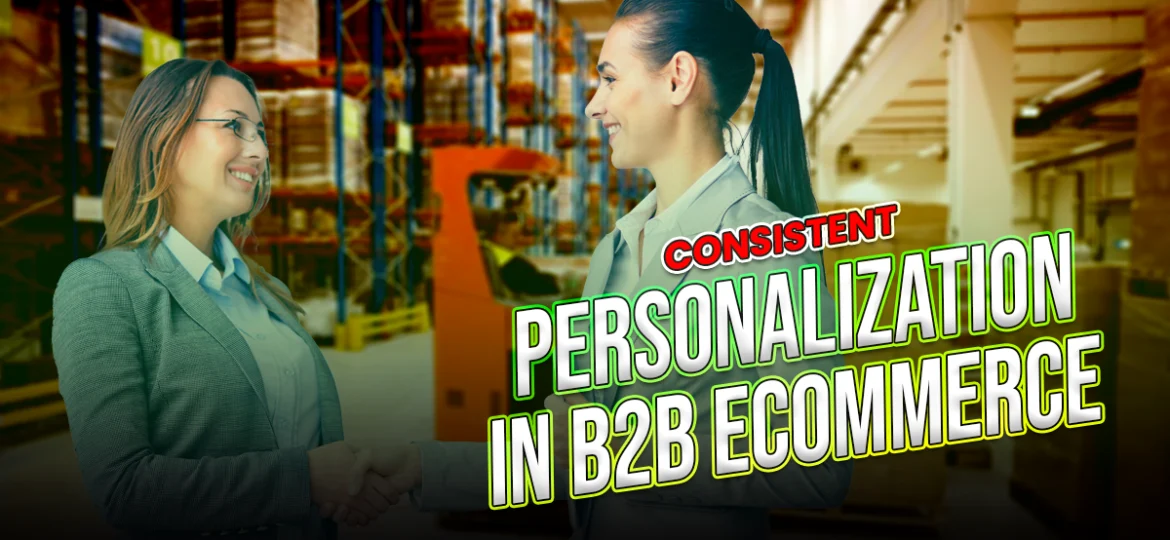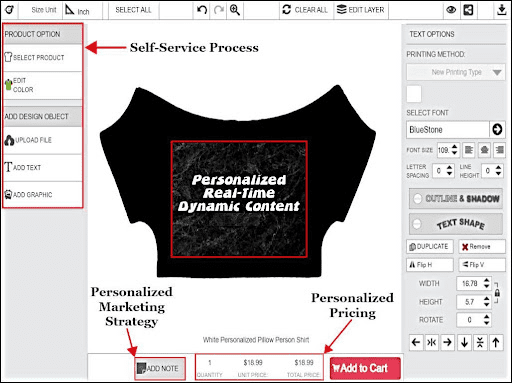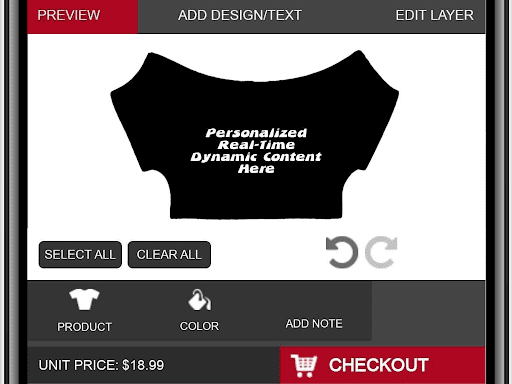
Last Updated on February 13, 2025
The 2024 Edelman Trust Barometer finds that consumers have less than 60% trust in businesses as more and more innovation is being implemented.
That is a scary statistic thing to think about at the start of 2024. Businesses want to grow, and innovation in the industry is how a business gains growth. So, with this rift between innovation and trust, consistency has become increasingly important in the new business trends.
One way that businesses are ensuring innovation is through personalization. Companies like Amazon and Netflix have pioneered this movement, taking over the whole eCommerce industry. However, with new business trends, even personalization can be challenging for their eCommerce store.
That is where consistent personalization in B2B eCommerce is essential. In this article, I will discuss creating consistent personalization in your traditional and eCommerce store.
Table of contents
How To Decide What To Personalize?
When creating a brand, brand storytelling is essential, and personalization can help with that. But precisely what should be personalized for that to be successful for eCommerce? The answer is quite simple: anything. Anything that matches your eCommerce brand’s goals and objectives can be personalized. In the realm of Personalization In B2B eCommerce, businesses must carefully consider what aspects to personalize to create meaningful engagement. So here are some questions you should consider when deciding what to personalize:
- What type of personalization can you do for your business?
- What do the customers want from your business?
- Can they afford personalization and personalized products?
- What personalization would bring in more customer engagement?
- What part of personalization will ensure customer satisfaction?
When you want to apply personalization to your business, you have to have answers to these questions. There is no clear answer for each of them, which is why many customers fear companies innovating. That is why customer feedback and getting the right analytics and data are essential. These will help answer these questions, and you can start your journey into personalization for eCommerce.
5 Practices To Maintain Consistent Personalization In B2B eCommerce
When you have decided what to personalize for your brand, the next step is to create consistent personalization. In the world of Personalization In B2B eCommerce, maintaining consistency is crucial to building trust and engagement with your customers. Here are some practices your eCommerce store should implement for consistent personalization across your branding.
- Develop Buyer’s Persona With Personalization
- Tailor Customer Experience Consistent Omnichannel Communication
- Personalize Customer Support
- Gathering Data Through Customer Feedback
- Optimize Your Store And Product Page
Practice #1 Develop Buyer’s Persona With Personalization
In e-commerce, personalized buyer personas are essential for a customized shopping journey. Simply put, it targets a specific type of customer you want at your shop through your marketing efforts. Data analytics tools help analyze customer behavior and preferences, enabling businesses to tailor strategies effectively.
And what better way to develop a buyer’s persona than with personalization? Personalization allows you to reach a broader range of customers but also ensures that you cater to each customer’s needs. When your brand matches the specific needs with personalization, you remain consistent with your customer base.
Practice #2 Tailor Customer Experience Consistent Omnichannel Communication
If you want to maintain that consistency of buyer’s persona with personalization, you must retain it everywhere. That is where you need to ensure that consistency remains through all channels.
That is what omnichannel experience means. The message must remain the same through emails, social media, or face-to-face interactions. If you can stay consistent in your marketing and communication channels, customers will feel more trust in your eCommerce store.
Practice #3 Personalize Customer Support
Trust can be easily lost, but there are ways to help build it back up again. That is where a support team to back up your eCommerce store is a helpful practice to build that trust again. The support team helps enhance the customer experience for those unsatisfied customers and keeps up with brand consistency.
Then, it is necessary to make it easy for customers to contact the support team. This could be done through a live chat on your store page, like the native live chat feature that Shopify provides for eCommerce businesses. You may also open up a ticket system on your or let customers contact the customer support email. The main thing here is to remain consistent with customers and create a personalized shopping experience for your customers.
Practice #4 Gathering Data Through Customer Feedback
Creating a buyer’s persona cannot be done without hearing back from your customers. For either traditional or eCommerce stores, customer feedback is essential. Customer feedback is the way you gather data and information from your customers. The feedback can be collected through social media comments, customer reviews, signups on your website, website analytics, and many other ways.
When you collect data, using Personalization In B2B eCommerce works much better. You learn things like who your customers are, what they like to buy, how they find your store, and what problems they face. With this information, you can make the shopping experience feel more personal. This helps make your store pages look the same and can fix problems like customers leaving their carts behind. It also helps keep customers interested and coming back.
Practice #5 Optimize Your Store And Product Page
Personalization means less if you don’t have your store and product page optimized. WebsiteBuilderExpert’s research shows that 82% of customers are discouraged from purchasing if the store page is slow.
Too much personalization on your website can add to the load speed of your eCommerce store. That is why optimizing your website to help your customers is so important. Also, ensure your store’s navigation is easy with side panels and search boxes, which can be used to look for specific products.
On the other hand, personalization in B2B eCommerce can make it easier for customers to find what they need through smart recommendations. This means the website is both well-organized and customized for each user. So, any personalization added should help customers have a better and smoother shopping experience.
5 Strategies For Consistent Personalization For Your eCommerce Store
Product personalization strategies can be tricky when combined with maintaining consistent personalization. So here are some strategies you can implement in your store for brand consistency:
- Real-Time Dynamic Content
- Personalized Marketing
- Personalized Pricing
- Mobile Personalization
- Using A Self-Service Process
Strategy #1 Real-Time Dynamic Content
There is nothing more eye-catching than having things change right before your eyes. That is what dynamic content brings to your eCommerce store.
Take, for example, Netflix’s personalized recommendations. It changes according to the user. Since no two users are alike, the shows and movies recommended are always different for each user. each user. This level of Personalization In B2B eCommerce can be a game-changer, offering tailored experiences that drive engagement and conversions.
Netflix does it all in real-time as you browse their catalog. It changes to show what you might be interested in. Personalization such as this increases customer engagement. They might even consume content they might have otherwise not been aware of.
The same concept can be applied to your eCommerce store, where real-time dynamic content enhances Personalization In B2B eCommerce, increasing customer engagement and bringing more visibility to other products in your store. It keeps the personalization consistent, making your store more engaging and customer-friendly.
Strategy #2 Personalized Marketing
Marketing is a great way to engage with your customers. Traditional stores have the advantage of face-to-face interaction, which eCommerce stores lack. Therefore, personalized marketing helps bring the customer closer to your store.
There are various types of marketing strategies that you can use for your store. For example, personalization in B2B eCommerce plays a crucial role in email marketing, allowing you to keep in touch with customers after their purchase. You can update your customer about their purchase with a personalized email.
Emails can also be used for promotional services or new product launches on your website. Cart abandonment reminders can help reduce such a problem for your eCommerce stores. Consistent personalization like these helps increase your store’s average order value.
Strategy #3 Personalized Pricing
Personalized pricing is another strategy that will help keep your store consistent. This can be regional pricing based on the location of the customers, which is great if your store caters to the international market.
Other personalized pricing strategies can be used to give returning customers discounts based on their purchase history with your store. This increases customer retention while also increasing loyalty to your store. Personalized pricing gives your store a competitive advantage over similar stores.
Strategy #4 Mobile Personalization
More and more people are now engaging with eCommerce websites through their mobile devices, and that trend will only increase. That is why whatever personalization you provide for your customers should also apply to your customers browsing their smartphones. In fact, Personalization In B2B eCommerce must extend to mobile platforms to ensure a seamless and engaging experience across all devices.
Mobile personalization is not just about tapping into the mobile device market but also about accessibility. Not everyone has access to a desktop or a laptop all the time because they are bigger and more complicated to carry around. With smartphones, your customers can shop while on the move, making mobile-friendly Personalization In B2B eCommerce a crucial strategy for driving engagement, enhancing user experience, and ultimately increasing conversions.
Strategy #5 Using A Self-Service Process
Self-service processes are a big thing in eCommerce right now. It allows customers to interact with the products like in a traditional store. It creates the engagement customers crave from a brick-and-mortar store translated into an eCommerce store.
For example, a customer wants to buy a shirt, pants, and coat. But they are unsure of the colors they want to match the outfit they are going for. Now, if an online store allows a custom model on the store page to add the clothes and lets them choose the color, that becomes interactive for the customer.
Self-service processes like this example are what eCommerce stores lack. However, there is a way to combine all the strategies mentioned above in one place: your Shopify store.
Using A Product Personalizer To Combine Personalization Strategies
So, let’s review the strategies I mentioned in the previous section. We have real-time dynamic content, a self-service process, personalized pricing, mobile personalization, and personalized marketing.
If you own a store on Shopify, the Shopify App Store has many apps that can help you use these strategies individually.
But here is an actual Shopify store using a product personalizer app to combine all the above-mentioned strategies in one on their product page:

As you can see from the picture, I have highlighted the parts where the app uses the strategies I mentioned.
The app allows customers to customize the product and see the changes they make in real-time. It creates dynamic content that customers can interact with other than button presses to purchase.
This is a prime example of Personalization In B2B eCommerce, where customer engagement and interactivity take center stage.
Then you will see the price of the product. Since personalized products might cost a bit more than regular products, it is essential not to keep costs hidden from your customers. This app allows the store always to show the product’s price and see if there are any changes with your personalization.
Not only that, but this type of app is also mobile-friendly. This means you get the same experience as on a desktop or a laptop. It makes the app more accessible and ticks off the mobile personalization strategy. See this picture below of the same app being used on a smartphone with the same features:

It has all the same features as the desktop in the compact yet intuitive layout for mobile devices. All the strategies mentioned can be implemented for mobile devices.
The process is a self-service, and it is all on its own. Customers using this app can design the product however they want. Of course, there will be some limitations with the rules and guidelines the store owner has placed, such as the area they can design on. However, it gives the customers control over the product and how they want it to be. This control is essential for the customers to engage further with your store.
Finally, the most hidden among the strategies is personalized marketing. Looking closely, you will see an ‘add note’ button. This note is for the store owner and how the customer wants the final product to look. It invites the customers to engage with real people by clicking a button, making the product more personalized.
Why Use A Product Personalizer For Your Shopify Store?
This intimate experience a product personalizer app creates for the customer gets them hooked on the page. They can have fun with the design and enjoy the shopping experience innovatively. When they have fun with consistent personalization like this, it only benefits your Shopify store.
You get customers engaged, satisfied, and more likely to proceed with the purchase. You might also get a loyal customer because other stores might not be able to give them this type of shopping experience. Loyal customers are more likely to recommend this type of store to others. Word-of-mouth marketing improves the discoverability of your store to a whole new audience.
From just one app, you cater to an individual customer’s need. You must integrate the app into your store and allow customers to interact with the product page. So make sure the app you get for your Shopify store is consistent with your brand. That way, you get to have consistent personalization in B2B eCommerce.
Bottom Line
Consistency is key to success for eCommerce stores. This consistency has to remain the same for the entirety of the store for that success to come. With personalization becoming more and more the focal point for marketing, your eCommerce branding must match the personalization you implement. Consistent personalization in B2B eCommerce is how you can gain an advantage over your competitors. With these practices and strategies, your eCommerce store can maintain consistency for success.

